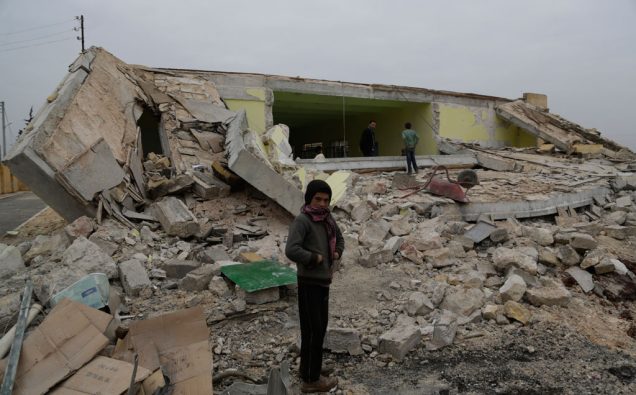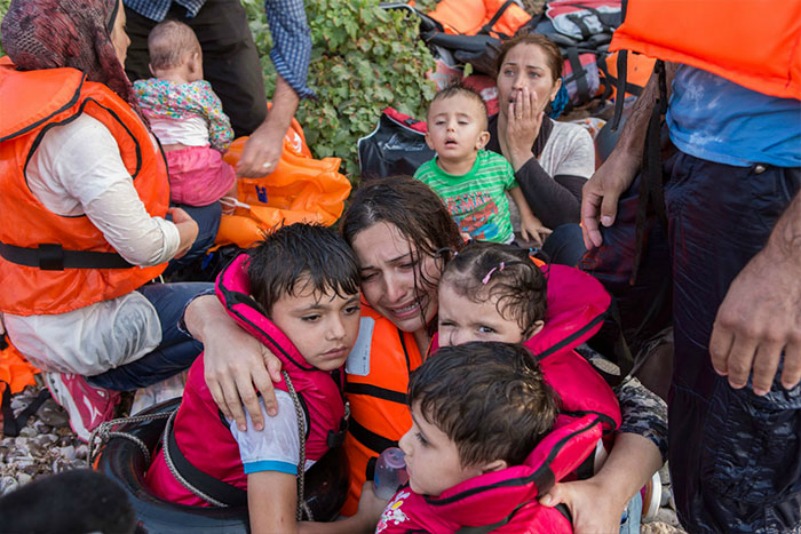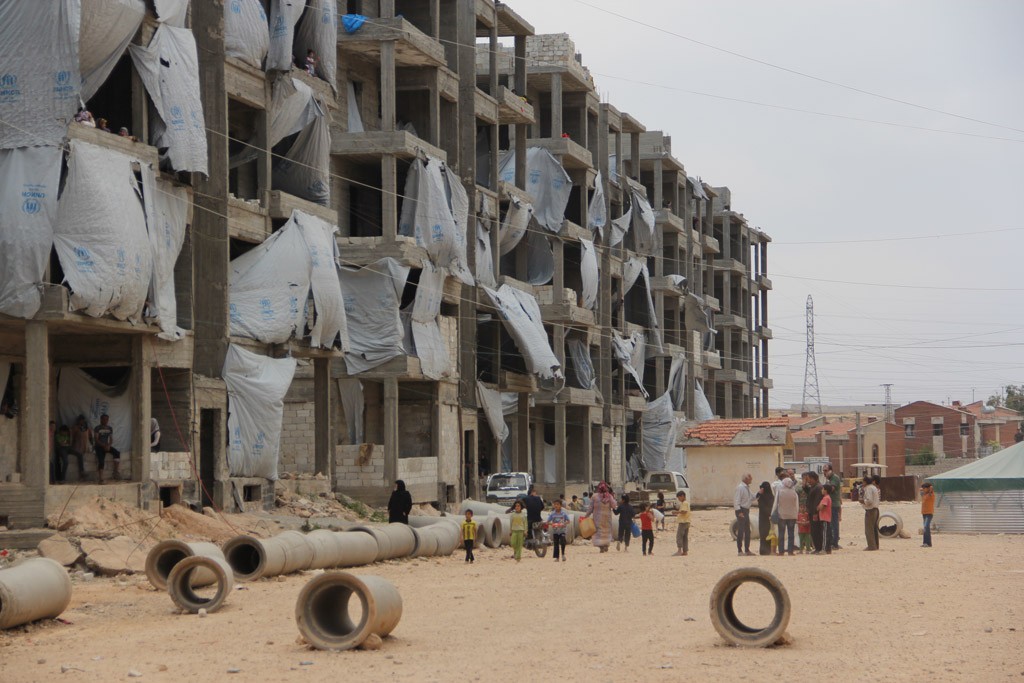
A child standing in front of his ground-flattened school after a bombardment in Ainjara village in rural Aleppo, Syria. Photo: UNICEF/Khalil Alshawi
The United States will maintain a long-term presence in Syria to defeat the ISIS as well as counter Iranian influence, Rex Tillerson, the top U.S. diplomat said.
Secretary of State Tillerson outlined reasons for American engagement in the war-devastated country in a speech on Wednesday, terming the ISIS, and Iran as threats to the United States.
Tillerson spoke on The Way Forward for the United States Regarding Syria at Hoover Institute at Stanford University Stanford in California as the Middle Eastern country reeled from almost 7 years of civil conflict and regional imbroglio.
Around half a million Syrians have been killed in the conflict, which began when civilians rose up against the dictatorial regime of Bashar al Assad and demanded democracy for the country in 2011 amid Arab Spring movements for democratic rights.
Millions of Syrians have been struggling to survive as refugees and displaced people within the country as well as in the regional countries.
“Syria remains a source of severe strategic threats, and a major challenge for our diplomacy,” Tillerson said.
Here are excerpts from Tillerson’s speech:
“As we survey Syria today, we see the big picture, a situation characterized by principally three factors:
ISIS is substantially, but not completely defeated.
The Assad regime controls about half of Syria’s territory and its population.
And continued strategic threats to the U.S. from not just ISIS and al-Qaida, but from others persist. And this threat I’m referring to is principally Iran.
As part of its strategy to create a northern arch, stretching from Iran to Lebanon and the Mediterranean, Iran has dramatically strengthened its presence in Syria by deploying Iranian Revolutionary Guard troops; supporting Lebanese Hizballah; and importing proxy forces from Iraq, Afghanistan, Pakistan, and elsewhere. Through its position in Syria, Iran is positioning to continue attacking U.S. interests, our allies, and personnel in the region. It is spending billions of dollars a year to prop up Assad and wage proxy wars at the expense of supporting its own people.
Additionally, the unresolved plight of millions of Syrian refugees and IDPs remains a humanitarian crisis. The catastrophic state of affairs is directly related to the continued lack of security and legitimate governance in Syria itself. Assad has gassed his own people, he has barrel bombed entire villages and urban neighborhoods, and repeatedly undermined any chance for a peaceful resolution of political differences. Those abuses continue to this day, as seen in recent civilian casualties in East Ghouta and Idlib Governance[1]. There is no way to effectively facilitate a large-scale safe and voluntary return of refugees without a political solution.
In short, Syria remains a source of severe strategic threats, and a major challenge for our diplomacy.
But the United States will continue to remain engaged as a means to protect our own national security interest.
The United States desires five key end states for Syria:
First, ISIS and al-Qaida in Syria suffer an enduring defeat, do not present a threat to the homeland, and do not resurface in a new form; that Syria never again serves as a platform or safe haven for terrorists to organize, recruit, finance, train and carry out attacks on American citizens at home or abroad or against our allies.

A Syrian mother cries with relief as she embraces her three young children after a rough sea crossing.
Photo Credit: UNHCR/Ivor Prickett
Second, the underlying conflict between the Syrian people and the Assad regime is resolved through a UN-led political process prescribed in UN Security Council Resolution 2254, and a stable, unified, independent Syria, under post-Assad leadership, is functioning as a state.
Third, Iranian influence in Syria is diminished, their dreams of a northern arch are denied, and Syria’s neighbors are secure from all threats emanating from Syria.
Fourth, conditions are created so that the refugees and IDPs can begin to safely and voluntarily return to Syria.
And fifth, Syria is free of weapons of mass destruction.
The Trump administration is implementing a new strategy to achieve these end states. This process largely entails increased diplomatic action on the heels of our ongoing military successes. Our diplomatic efforts will be characterized by stabilization initiatives and a new emphasis on the political solution to the Syrian conflict.
But let us be clear: The United States will maintain a military presence in Syria focused on ensuring ISIS cannot re-emerge. Our military mission in Syria will remain conditions-based. We cannot make the same mistakes that were made in 2011 when a premature departure from Iraq allowed al-Qaida in Iraq to survive and eventually morph into ISIS. It was that vacuum that allowed ISIS and other terrorist organizations to wreak havoc on the country. And it gave ISIS a safe haven to plan attacks against Americans and our allies. We cannot allow history to repeat itself in Syria. ISIS presently has one foot in the grave, and by maintaining an American military presence in Syria until the full and complete defeat of ISIS is achieved, it will soon have two.
We understand that some Americans are skeptical of continued involvement in Syria and question the benefits of maintaining a presence in such a troubled country.
However, it is vital for the United States to remain engaged in Syria for several reasons: Ungoverned spaces, especially in conflict zones, are breeding grounds for ISIS and other terrorist organizations. The fight against ISIS is not over. There are bands of ISIS fighters who are already beginning to wage an insurgency. We and our allies will hunt them down and kill them or capture them.
Similarly, we must persist in Syria to thwart al-Qaida, which still has a substantial presence and base of operations in northwest Syria. As in the years before 9/11, al-Qaida is eager to create a sanctuary to plan and launch attacks on the West. Although ISIS is the terrorist group that has dominated the headlines most in the last few years, al-Qaida is still a grave threat and is looking to reconstitute in new and powerful ways.
Additionally, a total withdrawal of American personnel at this time would restore Assad and continue his brutal treatment against his own people. A murderer of his own people cannot generate the trust required for long-term stability. A stable, unified, and independent Syria ultimately requires post-Assad leadership in order to be successful. Continued U.S. presence to ensure the lasting defeat of ISIS will also help pave the way for legitimate local civil authorities to exercise responsible governance of their liberated areas. The departure of Assad through the UN-led Geneva process will create the conditions for a durable peace within Syria and security along the borders for Syria’s neighbors.
U.S. disengagement from Syria would provide Iran the opportunity to further strengthen its position in Syria. As we have seen from Iran’s proxy wars and public announcements, Iran seeks dominance in the Middle East and the destruction of our ally, Israel. As a destabilized nation and one bordering Israel, Syria presents an opportunity that Iran is all too eager to exploit.
And finally, consistent with our values, America has the opportunity to help a people which has suffered greatly. We must give Syrians a chance to return home and rebuild their lives. The safe and voluntary return of Syrian refugees serves the security interests of the United States, our allies, and our partners. To relieve the enormous pressure of refugee flows on the surrounding region and on Europe, conditions must be created for these refugees to safely and voluntarily return home. It will be impossible to ensure stability on one end of the Mediterranean, in Europe, if chaos and injustice prevail on the other end, in Syria.

In the Tishreen camp for displaced persons in Aleppo, Syria, residents go about their daily lives. Photo Courtesy UNICEF/Razan Rashidi
The United States, along with its allies and partners, will undertake the following steps to bring stability and peace to Syria:
First, stabilization initiatives in liberated areas are essential to making sure that life can return to normal and ISIS does not re-emerge. Stabilization initiatives consist of essential measures such as clearing unexploded land mines left behind by ISIS, allowing hospitals to reopen, restoring water and electricity services, and getting boys and girls back in school. The approach has proved successful in Iraq, where millions of Iraqis have returned to their homes. In Syria, however, unlike in Iraq, we do not have a national government partner for stabilization efforts, so we must work with others. As such, there is a great deal of difficulty to them. Since May, the United States has deployed additional diplomats to the affected areas in Syria, working with the United Nations, our partners in the Global Coalition to Defeat ISIS, and various nongovernmental organizations.
Our work to help local and regional authorities provide services to liberated areas builds trust between local populations and local leaders who are returning. Terrorists thrive under conditions that allow them to peddle their warped and hateful messages to vulnerable people in conflict-stricken areas. Our stabilization efforts will help those people turn away from the prospect of terrorism and toward integration in their local communities.
We must be clear: “Stabilization” is not a synonym for open-ended nation-building or a synonym for reconstruction. But it is essential. No party in the Syrian conflict is capable of victory or stabilizing the country via military means alone. Our military presence is backed by State Department and USAID teams who are already working with local authorities to help liberated peoples stabilize their own communities.
Simultaneous with stabilization efforts, de-escalating the overall conflict is also a critical step to creating the conditions for a post-Assad political settlement. Since July, the United States has worked with Russia and Jordan to establish the de-escalation area in the southwest part of Syria. It has achieved a ceasefire, ended indiscriminate bombing of civilian populations, and with some few exceptions, has thus far held up well. The agreement in the southwest also addresses Israel’s security by requiring Iranian-backed militias, most notably Hizballah, to move away from Israel’s border. We need Russia to continue to work with the United States and Jordan to enforce this de-escalation area. If it does, the resulting cessation of regime-opposition hostilities will allow for the safe delivery of humanitarian aid, create the conditions for the safe and voluntary return of IDPs and refugees, and provide the Syrian people the security to start rebuilding areas scarred by conflict. Our efforts have been – have helped refugees and IDPs return into the southwest de-escalation areas from where they had taken refuge in Jordan, and overall, an estimated 715,000 Syrians in total, including 50,000 Syrians from abroad, returned to their homes in 2017. These early but positive trends can increase through the continuation of de-escalation efforts not just in the southwest, but elsewhere.
On counterterrorism, we will continue to work with allies and partners, such as Turkey, to address the terror threat in Idlib and address Turkey’s concern with PKK terrorists elsewhere. Al-Qaida is attempting to re-establish a base of operation for itself in Idlib. We are actively developing the best option to neutralize this threat in conjunction with allies and partners.
The United States is vigorously supporting UN efforts to achieve the political solution under UN Security Council Resolution 2254. This is the political framework for peace and stability in a unified Syria which has already been agreed upon by members of the UN Security Council. Specifically, we will work through what is known as the Geneva process, supporting UN Special Envoy for Syria Staffan de Mistura in his efforts.”

















